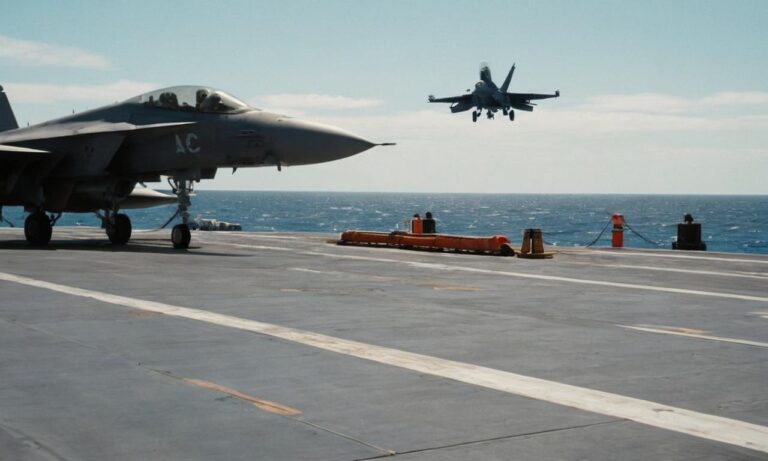Planes landing on aircraft carriers, a complex and awe-inspiring maneuver, involves a precisely orchestrated sequence of actions that demand both skill and technology.
Planes landing on aircraft carriers, a complex and awe-inspiring maneuver, involves a precisely orchestrated sequence of actions that demand both skill and technology. Aircraft carriers, as mobile airfields, facilitate the landing of various types of aircraft in a limited space, requiring specialized techniques for safe and successful landings.Landing Systems and Techniques
Aircraft carriers deploy several critical systems to assist in the landing of planes:
- Flight Deck: The primary landing area, equipped with arresting cables and a landing area, where skilled pilots attempt to touch down.
- Arresting Gear: Vital for stopping the aircraft in a short distance, composed of wires stretched across the deck that engage a hook on the plane’s tail upon landing.
- Optical Landing System (OLS): An array of lights and lenses aiding pilots in maintaining the correct approach angle and descent rate during landing.
The Landing Sequence
When a plane approaches an aircraft carrier for landing, it initiates a series of precise maneuvers:
- Initial Approach: The pilot aligns the aircraft with the carrier’s deck, following guidance from the OLS and adjusting speed and altitude accordingly.
- Engagement: As the plane touches the deck, the arresting hook engages the cables, rapidly decelerating the aircraft.
- Go-Around: In case of a missed landing, pilots execute a go-around, circling for another attempt or diverting to an alternative landing site.
Challenges and Expertise
Landing on an aircraft carrier presents significant challenges:
| Weather Conditions: Variable wind speed and direction, precipitation, and visibility affect the landing process. | Deck Size: The limited space demands precision and split-second decision-making from pilots. |
Mastering carrier landings requires rigorous training, honed skills, and an exceptional level of situational awareness. Pilots undergo extensive simulations and practice to ensure proficiency in executing these demanding maneuvers.
Conclusion
The process of landing planes on aircraft carriers epitomizes the fusion of advanced technology, skillful piloting, and meticulous planning. As a fundamental aspect of naval aviation, it remains a testament to human ingenuity and precision engineering.
htmlC
Landing Safety Measures
Safety in aircraft carrier landings is paramount, bolstered by various measures:
Safety Gear and Protocols
Aircraft carriers are equipped with safety measures such as:
- Crash Barriers: Positioned at the end of the deck, these hydraulic barriers provide an emergency stop for planes unable to land safely.
- Firefighting Equipment: Immediate access to firefighting tools and personnel stands ready in case of emergency landings.
- Emergency Response Teams: Trained personnel stationed strategically for immediate response in case of accidents during landing attempts.
Weather Contingencies and Readiness
Weather plays a pivotal role, demanding preparedness:
- Wind Gauging: Constant monitoring and updates on wind speed and direction for real-time adjustments during landings.
- Visibility Enhancements: Use of advanced technologies to augment visibility during adverse weather conditions.
- Emergency Diversions: Contingency plans in place to redirect planes to alternative landing sites in case of extreme weather conditions.
Frequently Asked Questions
Q: Are all planes capable of landing on aircraft carriers?
A: Not all planes possess the necessary features, such as reinforced landing gear or tailhooks, to safely land on carriers. Carrier-based aircraft undergo specific design considerations for these unique landings.
Q: How long does it take for a pilot to master carrier landings?
A: Mastery of carrier landings is a continuous process. Pilots undergo rigorous training, often requiring years to achieve proficiency, including simulations, practice, and real-time experience.
Q: What happens if a plane misses the arresting cables during landing?
A: If a plane misses the cables, it performs a “bolter,” immediately applying full throttle to abort the landing and initiate a go-around for another attempt.






